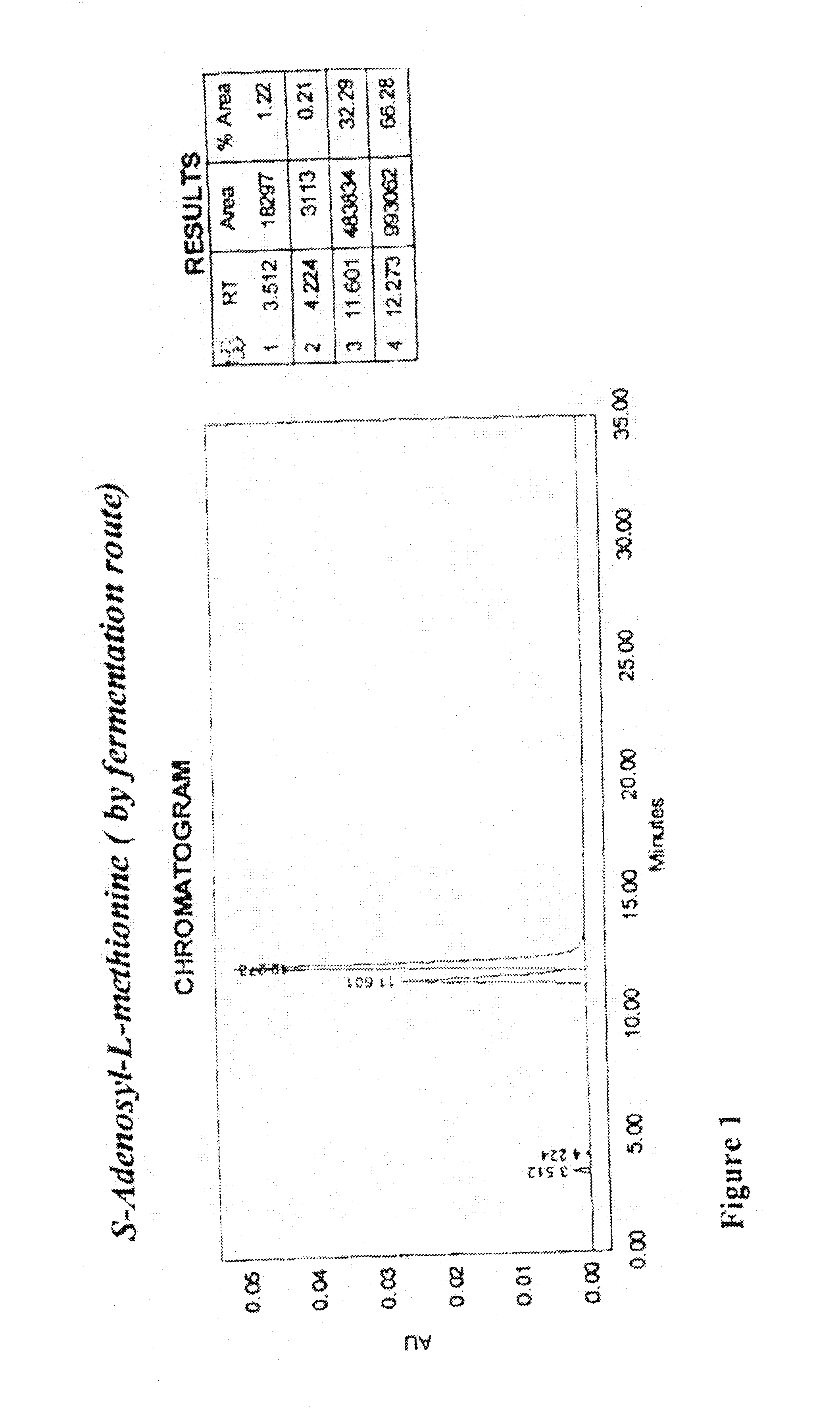Chemical synthesis of S-adenosyl-L-methionine with enrichment of (S,S)-isomer
a technology of sadenosyllmethionine and enrichment, which is applied in the direction of chemistry apparatus and processes, sugar derivates, organic chemistry, etc., can solve the problems of high investment, difficult isolation of required enzymes from natural sources, and many limitations of the above methods in productivity per day, so as to achieve more eco-friendly and economical effects
- Summary
- Abstract
- Description
- Claims
- Application Information
AI Technical Summary
Benefits of technology
Problems solved by technology
Method used
Image
Examples
example 1
Preparation of 5′-Chloromethyl Adenosine Hydrochloride
[0050]Adenosine (100 Kg) was suspended in acetonitrile (350 Lit) and cooled to 0° C. Thionyl chloride (82.5 Lit) was slowly added in 60 min controlling the reaction temperature at 5° C. The reaction mixture was stirred at 5° C. for 4 h. The temperature was allowed to raise to 30-35° C. and maintained at this temperature for 15 h. The reaction was monitored by HPLC and thereafter cooled to 10° C. DM water (900 Lit) was added and the pH was adjusted to 9.5 using 15% ammonia solution (950 Lit). The reaction mass was cooled to 5° C. and stirred for 2 h. The product was filtered and washed with chilled water (300 Lit). Wet cake was dried under vacuum at 40° C.[0051]Yield: 100 Kg[0052]HPLC purity: 99.5%
example 2
Preparation of L-Homocysteine Sodium Salt
[0053]To DM water (400 Lit), liquid ammonia (4.5 Kl) was charged and the mixture was cooled to −40° C. To this L-methionine (100 Kg) was charged. Sodium metal pieces (80 Kg) were slowly charged into the above mixture in 2.5 h, while controlling the reaction temperature at −35 to −40° C. The progress of the reaction was monitored by HPLC. Liquid ammonia was evaporated, compressed and stored for recycling. DM water (400 Lit) was charged and the solution was used as such for next reaction. The total weight of the solution was about 850 Kg.
example 3
Preparation of S-Adenosyl-L-Homocysteine
[0054]L-Homocysteine sodium salt solution (850 Kg), prepared as described above, was cooled to 10° C. and dil.hydrochloric acid (1:1; 100 Lit) was added til the pH became 11.3 to 11.5. To this solution, 5′-Chloromethyl adenosine hydrochloride (135 Kg) and potassium iodide (13.5 Kg) were added and stirred at 70-80° C. for 5 h. The reaction was monitored by HPLC and cooled to 15° C. Dil.hydrochloric acid (1:1; 200 Lit) was added to bring down the pH to 2.0. Activated carbon (10 Kg) was added, stirred for 30 min and filtered. To the mother liquor, ammonia solution (15%) was added to set the pH to 6.0-6.2. The precipitate was stirred at 20° C. for 24 h and filtered. The solid was washed two times with water (200 Lit). The wet cake was dried at 40° C. under vacuum.[0055]Yield: 135 Kg[0056]HPLC purity: 99.5%
PUM
| Property | Measurement | Unit |
|---|---|---|
| temperature | aaaaa | aaaaa |
| temperature | aaaaa | aaaaa |
| temperature | aaaaa | aaaaa |
Abstract
Description
Claims
Application Information
 Login to View More
Login to View More - R&D
- Intellectual Property
- Life Sciences
- Materials
- Tech Scout
- Unparalleled Data Quality
- Higher Quality Content
- 60% Fewer Hallucinations
Browse by: Latest US Patents, China's latest patents, Technical Efficacy Thesaurus, Application Domain, Technology Topic, Popular Technical Reports.
© 2025 PatSnap. All rights reserved.Legal|Privacy policy|Modern Slavery Act Transparency Statement|Sitemap|About US| Contact US: help@patsnap.com



